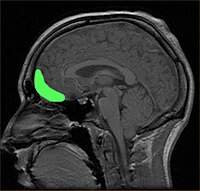
Photo from wikipedia
In the brain, decision making is instantiated in dedicated neural circuits. However, there is considerable individual variability in decision-making behavior, particularly under uncertainty. The origins of decision variability within these… Click to show full abstract
In the brain, decision making is instantiated in dedicated neural circuits. However, there is considerable individual variability in decision-making behavior, particularly under uncertainty. The origins of decision variability within these conserved neural circuits are not known. Here we demonstrate in the rat medial frontal cortex (MFC) that individual variability is a consequence of altered stability in neuronal populations. In a sensory-guided choice task, rats trained on familiar stimuli were exposed to unfamiliar stimuli, resulting in variable choice responses across individuals. We created a recurrent network model to examine the source of variability in MFC neurons, and found that the landscape of neural population trajectories explained choice variability across different unfamiliar stimuli. We experimentally confirmed model predictions showing that trial-by-trial variability in neuronal activity indexes the landscape and predicts individual variation. These results show that neural stability is a critical component of the MFC neural dynamics that underpins individual variation in decision-making.Behavioral responses vary considerably across individuals. Kurikawa et al. show experimentally and computationally how the observed spectrum of individual variances in decision-making emerges from neural dynamics of the medial frontal cortex.
Journal Title: Nature Neuroscience
Year Published: 2018
Link to full text (if available)
Share on Social Media: Sign Up to like & get
recommendations!